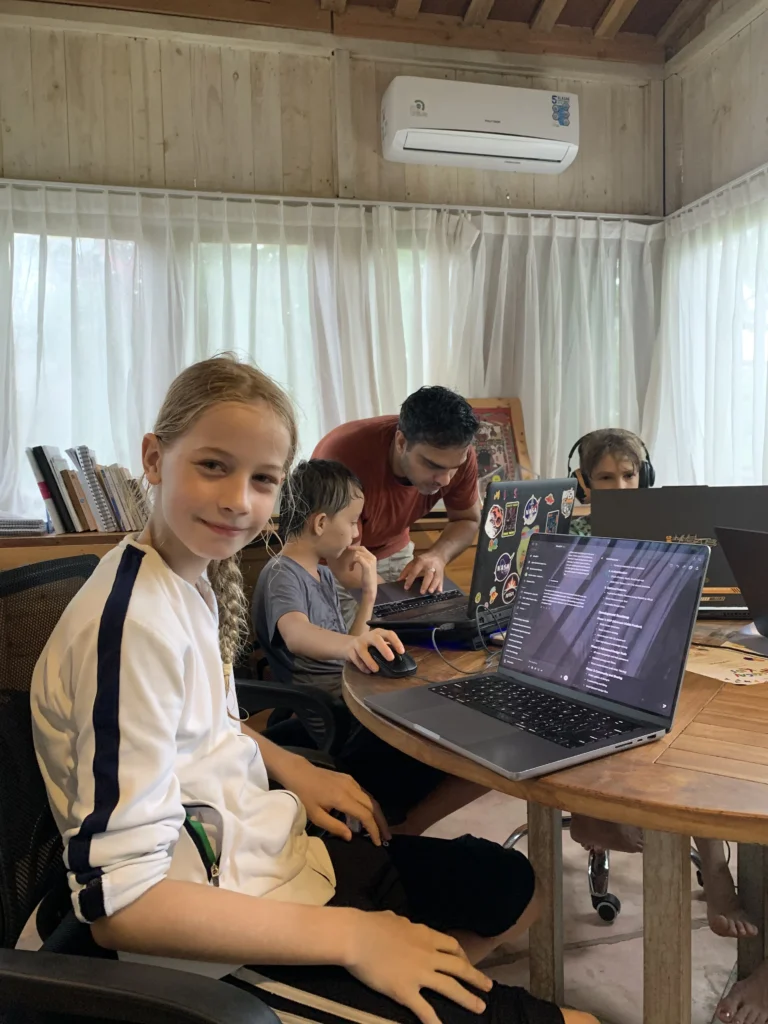Creativity is full of mystery. Almost everyone chases after it, but not everyone succeeds in finding it. Creative people are often admired because creativity has no exact formula. It feels almost magical, turning what once didn’t exist into something real. From science and art to solving everyday problems, creativity plays an important role in all aspects of life. That’s why many parents hope their children can grow up to be creative individuals. Interestingly, recent studies suggest that programming for kids can actually boost children’s creativity. But how is that possible? This article will dive deeper into the connection between coding and creativity in children.
Recent research supports this idea. A study titled Coding for Young Learners: Enhancing Computational Thinking and Creativity in Elementary Education found that fifth-grade students who participated in Scratch-based programming lessons improved their computational thinking scores from around 56.3 to 74.8, particularly in skills such as decomposition, pattern recognition, and algorithmic thinking.
Another study, Improving Creative Thinking Skill through Coding for All at Elementary Students (2024), showed that coding activities, such as collaboration, discussion, and creative projects – strengthened students’ creative thinking abilities. These are recognized as essential 21st-century skills, alongside critical thinking, communication, and collaboration.
Even at the preschool level, extracurricular coding activities have demonstrated benefits. Research at Joy Kids National Plus Kindergarten in Tasikmalaya revealed that through interactive STEAM-based coding exercises (like creating robot paths, error evaluation, and group discussions), children aged 5–6 developed stronger logic, problem-solving abilities, and creativity by generating new ideas during the coding process.
However, we also understand the challenge of introducing coding and programming to children. After all, even for adults, coding and programming are not easy skills to master, so it may seem even more difficult to teach them to kids. Yet, a study has found that children’s brains are actually more capable of processing complex concepts, precisely because they have not yet been burdened with the complicated problems that adults face. This makes childhood the perfect time to introduce programming for kids, giving them the opportunity to develop critical skills early on.
You might be wondering, what kinds of kids programming activities can we actually introduce to children? The answer is quite diverse. Starting as early as ages 4 to 7, children can already be introduced to coding games and simple app development. By using block-based apps such as ScratchJr, Lightbot, or CodeSpark Academy, you can teach them the basics of sequencing and logical thinking. They can also try unplugged coding, coding activities without a computer, where kids follow step-by-step instructions to escape a maze or pretend to be a robot carrying out specific commands. In addition, children at this age can also explore robotics play. Simple programming toys like Bee-Bot, Cubetto, or Kodable help kids understand cause-and-effect relationships, which lays the foundation for tackling more complex problems in the future.
That was kids programming for ages 4–7. But what about when our children reach ages 8–12? What kinds of programming activities are most effective at this stage? We recommend introducing them to Scratch projects, where kids can build animations, games, or interactive stories using MIT Scratch. This kind of activity naturally sparks their imagination and creativity. If your child enjoys Minecraft, you can also let them explore Minecraft Education Edition, which teaches logic, problem-solving, and coding concepts through a game they already love. For children who are more familiar with coding, you can specifically introduce Micro:bit or LEGO Robotics, which involve hands-on coding with small hardware and encourage experimentation. And what if your child loves reading and writing? Try storytelling with code, activities such as creating quizzes, digital comics, or interactive art. As you can see, no matter how diverse a child’s interests may be, there is always a way to connect them with kids programming.
In the last section, let’s look at programming for kids aged 13 and above, also known as teenagers. At this stage, you can start introducing Python basics, such as using Python with Turtle Graphics or Pygame to create games and visuals. That said, make sure the projects are aligned with the types of games they enjoy, so they can stay focused and more engaged with the topic. What about web development? Absolutely possible! Teenagers can already learn HTML, CSS, and JavaScript to build their very first personal websites, so you no longer need to shy away from these “complex” topics. Similarly, app development is also a great option, tools like Thunkable or MIT App Inventor allow them to create real mobile apps. You can even encourage participation in hackathons or coding clubs, which help develop teamwork, problem-solving, and creativity through group projects. Since children aged 13 and above already have stronger comprehension skills, the learning alternatives for kids programming can be taken to a more serious, and yes, more complex level.
To learn more about coding and programming for children, check out our article here: Scratch: A Visual Programming Language for Kids https://empathy.school/scratch-a-visual-programming-language-for-kids/. Besides being great for sparking creativity, coding and programming have also been scientifically shown to improve focus and strengthen analytical skills. A few studies support this: A randomized trial with fourth-graders showed that a learn-to-code program significantly improved children’s computational thinking skills, compared to control groups according to pubmed). Another study, from PMC, found that among children aged 5–6, coding (including through virtual environments like Code.org) boosted executive functions, especially response inhibition and planning.
In addition, some of the world’s top universities have also begun to consider children’s involvement in understanding the environment, including climate change issues, with a strong focus on the importance of child development. You can explore this further through the following link: https://developingchild.harvard.edu.
Don’t wait until tomorrow, start introducing your children to modernization, kids programming, and technological development today. Because the future of your children, our future, the future of humanity, begins today.


 Previous Post
Previous Post